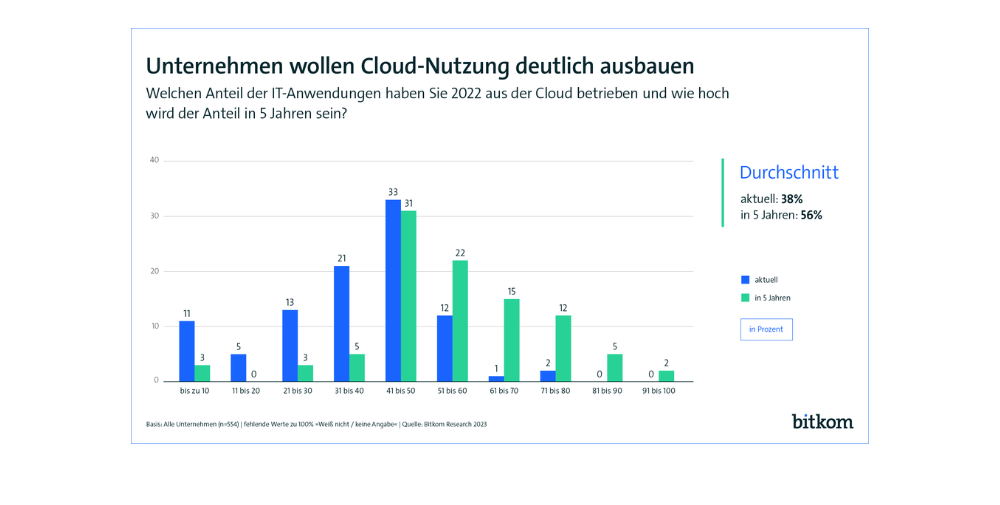
“Already today, virtually all companies use cloud applications. But the intensity of use will increase sharply in the coming years. Cloud is the new normal of the digital world”, says Bitkom CEO Dr. Bernhard Rohleder. “At the same time, however, it is also true that companies will not move all IT applications to the cloud, at least in the medium term.”
One in nine companies (11 percent) using the cloud has a “cloud only” strategy. That is, cloud computing is used for all applications and systems, and existing solutions are moved to the cloud. Another 36 percent have a “cloud first” strategy, meaning that cloud solutions are preferred for new projects and existing applications are moved to the cloud as needed. For 35 percent, “cloud too” applies, i.e. at least partially supplementing existing IT solutions with cloud applications. “Almost half of all companies prefer cloud solutions for new IT projects. This is a clear signal to software providers, some of whom still need to adapt their offerings,” says Rohleder. Companies are already using a wide variety of cloud offerings today. Storage space in the cloud is used most frequently (92 percent), followed by web conferencing (76 percent), general computing power for a wide range of applications as well as office software (73 percent each) and software for human resources, accounting and financial planning (72 percent). Cloud-based databases are used by 60 percent, ERP systems by 30 percent. But special applications such as IoT (37 percent) or AI services (32 percent) also come from the cloud.
Cloud should save costs and make it more sustainable
The most important goal for companies in their cloud activities is to cut costs (64 percent) and reduce CO2 emissions (63 percent). A majority of 57 percent each also want to move IT applications to platforms and software-as-a-service, as well as increase IT security. Other important goals include building platforms for cooperation with third parties (49 percent), digitizing internal processes (46 percent) and developing innovative products or services (43 percent). 39 percent also see a way out of the existing hardware shortage, which has hindered the expansion of their own data centers, 38 percent promise themselves access to innovative technologies such as IoT or AI through the cloud. Rohleder: “The cloud offers small and medium-sized companies in particular access to innovative technologies such as artificial intelligence – without high investment costs or special technical expertise in their own companies.”
Although many companies hope to make a contribution to climate protection through cloud solutions, they also see shadows as well as light in this area. 57 percent of all companies believe that cloud computing can save energy and resources. 59 percent think that cloud computing simplifies the preparation of sustainability reports. On the other hand, 48 percent also complain that energy and resource consumption in cloud computing is too intransparent, and three quarters (76 percent) say that cloud computing’s easy scalability means that software is programmed to be increasingly resource-hungry. “Cloud computing can help companies become more sustainable. In doing so, initiatives such as Green Coding can ensure that the provision of computing power and storage space at the click of a mouse does not lead to a loss of focus on resource consumption and therefore costs,” Rohleder said.
Cloud obstacle number one is the shortage of skilled workers.
Companies face many hurdles when implementing cloud projects. These hurdles exist within the company itself, are set externally, or involve very fundamental security issues. The biggest brake on the cloud market is the lack of qualified personnel (65 percent). Other significant internal obstacles are a lack of time (53 percent), overly complex migration tasks (52 percent) and excessive investment requirements (50 percent). Resistance within the company and a lack of external advice are holding back 42 percent each in their cloud projects. Only 35 percent state that the economic benefits are unclear to them. Other obstacles to cloud projects are excessive demands on IT security (59 percent) and data protection (56 percent) as well as regulatory conditions (51 percent), for example in certain sectors such as the financial industry or healthcare. Around two-thirds (64 percent) fear unauthorized access to sensitive data in the cloud, and 45 percent are afraid of data loss. “Moving to the cloud can significantly increase IT security in companies, especially for small and medium-sized enterprises that cannot afford a large IT department,” Rohleder said.
Cyber attacks on the cloud: only 1 percent report damage
In fact, two-thirds (64 percent) of companies using cloud computing say they have not had a cyberattack on the cloud environment at all in the past twelve months. A quarter (26 percent) report attacks, but their own security measures have taken effect. Only 1 percent were victims of a cyberattack on the cloud environment that caused severe disruption to operations.
With regard to security and data protection, 8 out of 10 companies (81 percent) that use cloud computing, are planning to do so or are discussing it, care about the country in which the cloud provider’s data center is located. The clear location favorite is Germany: 93 percent prefer a domestic data center, for 7 percent it is an option. The other EU countries follow at a considerable distance, preferred by 50 percent and considered by 41 percent. These are followed by Japan (18 percent prefer, 19 percent consider) and the USA (14 percent / 28 percent), as well as India (10 percent / 9 percent). Great Britain is preferred as a location by only 1 percent, but is at least a possibility for 44 percent. In contrast, China is out of the question for 96 percent, and a location in Russia is rejected by 100 percent. “Cloud computing will gain in importance and this requires high-performance, well-connected and secure data centers. If we prevent the operation of data centers in Germany through unrealistic requirements, such as an obligation to feed waste heat into non-existent district heating networks, we will weaken our digital sovereignty,” says Rohleder.
Every second company has interest in Gaia-X.
In line with these location preferences, the European cloud and data initiative Gaia-X is of interest to almost half of the companies (46 percent). 17 percent already have concrete plans to use Gaia-X compliant services, while another 29 percent can imagine doing so but have nothing planned yet. Forty-two percent are not currently interested in Gaia-X, and 11 percent have not yet formed an opinion or do not wish to state an opinion. Advantages of Gaia-X-compliant services are seen above all in the area of compliance and legal certainty in data protection (71 percent) and in particularly high standards for IT security (66 percent). Another important factor is the possibility of exchanging data in a sovereign and trustworthy manner (62 percent). “Gaia-X and closely related projects can make an important strategic contribution to advancing Germany and Europe in the areas of cloud, edge and data economy. The interest of companies is definitely there,” said Rohleder. “The crucial thing is that Gaia-X-compliant offerings become available on the market as quickly as possible.”
Further Links
www.bitkom.org
Presentation: Cloud Report 2023 – What role does the cloud play for the German economy?




